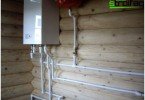Gas boilers for a private house
When the house is built and it is time to start conducting communications, one of the most difficult issues becomes the choice of a heating boiler. As a rule, the role of the main heating element is a water heating system. And all kinds of oil radiators, electric floor heating systems, infrared heaters, wood and electric fireplaces are used for additional heating. First you need to decide what type of fuel you prefer, and only then choose the model of the unit. It should be noted that in recent years, the most popular gas boilers – for a private house this is the best option.
Content
- The main types of fuel
- Types of gas equipment
- Location separation
- Differences in principle of operation
- Installing the pump on a gravity-driven heating system
- Progressive Condensing Boilers
- Division of gas boilers into categories
- Intended classification
- By type of heat exchanger
- According to the method of removal of combustion products
The main types of fuel
Depending on the type of energy or material burned, gas, electric, solid fuel and liquid fuel boilers are divided. Many manufacturers also offer a fairly large selection of so-called combined boilers that switch from one type of fuel to another. So in areas where there is no central gas supply, and electricity is often interrupted, it is very convenient to use boilers that can operate both on electricity and on solid fuel (coal, firewood, briquettes).
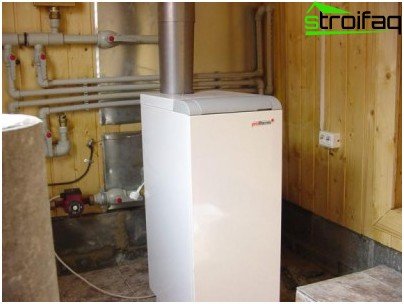
A floor gas boiler is the most popular type of equipment, its popularity is justified by its power, the ability to service two circuits
Making the final choice is based on the convenience and cost of operating heating equipment. The most economical are gas boilers, and they do not cause much trouble. Modern heaters are equipped with an automation system that ensures their uninterrupted operation with virtually no human intervention.
The indisputable advantages of gas heating include the lack of need to make fuel reserves, and high efficiency (up to 95%), and relative safety. In addition, a gas boiler often does not need a special room – a boiler room. And thanks to a rather attractive design, the unit will easily fit into the interior of your kitchen.
Types of gas equipment
In order to choose the right gas boiler for a private house, you must first understand how they differ from each other.
Location separation
There are floor and wall units. Wall mounted boilers, as a rule, are equipped with a copper heat exchanger, which leads to their low weight. It is because of the rapid burning of the copper heat exchanger at high loads that such boilers have a power limit of 35 kW. Floor boilers are equipped with a cast-iron heat exchanger and are indispensable for heating large areas.
Differences in principle of operation
Volatile boilers
This equipment is equipped not only with a burner and heat exchanger, but also with a circulation pump that pumps constant pressure into the system. With proper installation, such a boiler ensures that the coolant reaches all corners of the heating system, while maintaining the set temperature. In addition, the installation of the piping system for such a boiler is greatly facilitated, since in this case there is no need to observe a constant slope. Choosing such a gas boiler for the home, remember that when a power outage, volatile equipment does not work. So if in your area such troubles are not uncommon, stock up on a diesel or gasoline generator.
Non-volatile boilers
This is a fairly outdated type of gas equipment, which requires a larger diameter of the intra-house pipeline, compliance with the slope and the installation of an open expansion tank. However, if you supplement it with a circulation pump and slightly improve the house system, installation of gas boilers this type may be the best option for areas where power is often cut off.
Installing the pump on a gravity-driven heating system
Make it simple enough.
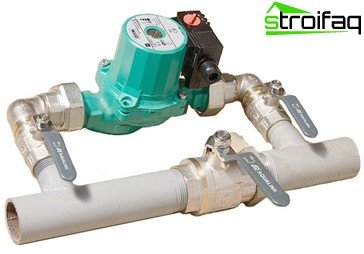
The circulation pump is built into the gravity heating circuit, if the system does not cope with the work and the temperature in the radiators installed at different points is significantly different
- On the return pipe, 20-30cm in front of the boiler entrance, it is necessary to construct a bypass on which the pump is installed.
- Before the pump it is necessary to install a filter of hard cleaning, which will prevent solid particles from entering the pump mechanism and thereby protect it from damage.
- A valve is installed on the return pipe between the inlet of the stroke and its output..
- The pump is connected to the mains. When the pump is in operation, the valve on the main pipe must be closed. If a power outage occurs, just open the valve and gravity circulation resumes.
Important! This switching method is possible only on the pipeline, originally prepared for the installation of a non-volatile boiler. That is, when all the slopes and diameters of the pipes are observed. In a system designed for pump installation, self-circulation of the coolant is not possible.
Progressive Condensing Boilers
This is the newest generation of heating equipment. In order to understand what its main difference is, you need to understand a little about the principles of operation of a conventional gas boiler. The fact is that together with the combustion products a significant part of the steam is discharged through the chimney, which leads to losses of thermal energy. Manufacturers do this absolutely consciously in order to prevent condensation inside the boiler, which can very quickly lead to corrosion of the boiler parts and its failure.
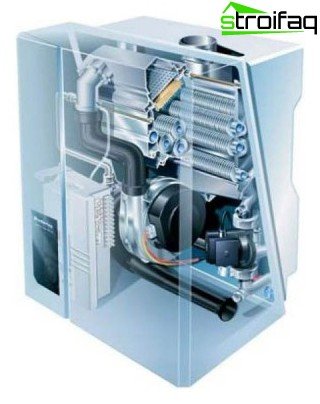
Sectional Condensing Boiler
Condensing gas boilers for the home are designed in such a way that the water vapor is cooled in the heat exchanger to the temperature at which condensate appears. This happens due to the interaction of steam with water from the return pipe. In this case, the coolant itself heats up, which means that heat losses are reduced.
It is most advantageous to install such equipment in houses where there is a water “warm floor”, that is, there are no radiators, and heating is carried out through a long pipeline laid under the floor.
Division of gas boilers into categories
Intended classification
Most often, at the time of selection, the question arises, the installation of a gas boiler of what type is more expedient – single-circuit or double-circuit. The single-circuit boiler is intended only for heating, and the double-circuit boiler also heats water for hot water supply. The answer to this question is quite simple: it all depends on the capacity of the boiler. If you plan to heat a large enough house, and therefore install a powerful boiler, it is more advisable to install a single-circuit heating system and a boiler separately. For a house with an area of up to 200 m2 you can use a dual-circuit system.
By type of heat exchanger
For a double-circuit boiler, it is very important to choose the right type of heat exchanger. The lifetime of the unit directly depends on this. There are bithermic heat exchangers operating on the principle of “pipe in pipe”, and devices with separate heat exchangers. In such boilers, a copper heat exchanger is used to heat the coolant, and stainless steel for hot water supply. Bithermal boilers are only suitable for heating water obtained from a central water supply system. If you use water from your own well or well, install a boiler with two heat exchangers.
According to the method of removal of combustion products
Another important characteristic of gas boilers is the method of removal of combustion products. Distinguish turbocharged (chimney) and chimney devices.
Installation of a gas boiler with a chimney system for the removal of combustion products, as the name implies, suggests the presence of a chimney with natural draft. In addition, in such units, combustion in an open chamber is maintained due to the intake of oxygen from the room where it is installed. Gas enterprises have very serious requirements for the installation sites of such boilers. As a rule, this should be a specially equipped boiler room.
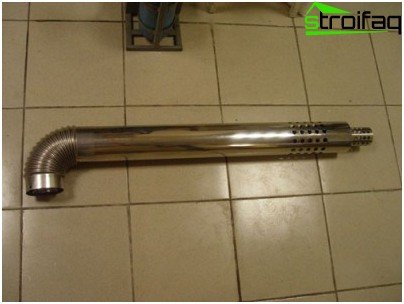
Coaxial pipe for a turbocharged gas boiler provides air supply and exhaust gases
Turbocharged boilers are equipped with a closed combustion chamber, to which oxygen is forcibly supplied from the street through a special pipe. And the combustion products are discharged by a fan. Most often, such devices are equipped with a coaxial pipe – carbon monoxide is discharged along the internal circuit, and combustion air is supplied through the external.
Automation and Security
Almost all modern heating systems are equipped with an automatic security system that blocks the operation of the boiler in the presence of any malfunction. Such a system will stop the gas supply if the burner goes out, which will protect you from poisoning. Most security systems also respond to the absence of smoke, water overheating, power outages and coolant overheating.

The automatic control system for the gas boiler provides control, adjustment, the possibility of changing the mode
When choosing a boiler, pay attention to whether the system automatically unlocks when troubleshooting. If after the security system has worked, the boiler must be turned on manually, then it will not work for people who are often not at home. If the heating is turned off for a long time in the winter, there is a danger of “defrosting” the heating system, which will lead to pipe rupture and entail the need to replace them.
Installation and maintenance of gas boilers
Remember that the installation and maintenance of gas equipment must be done by specialists of the gas company. Do not try to do it yourself. This can entail not only serious penalties, but also a danger to the life and health of your loved ones. Any work on the gas pipeline and gas equipment should only be carried out by specially trained people..


